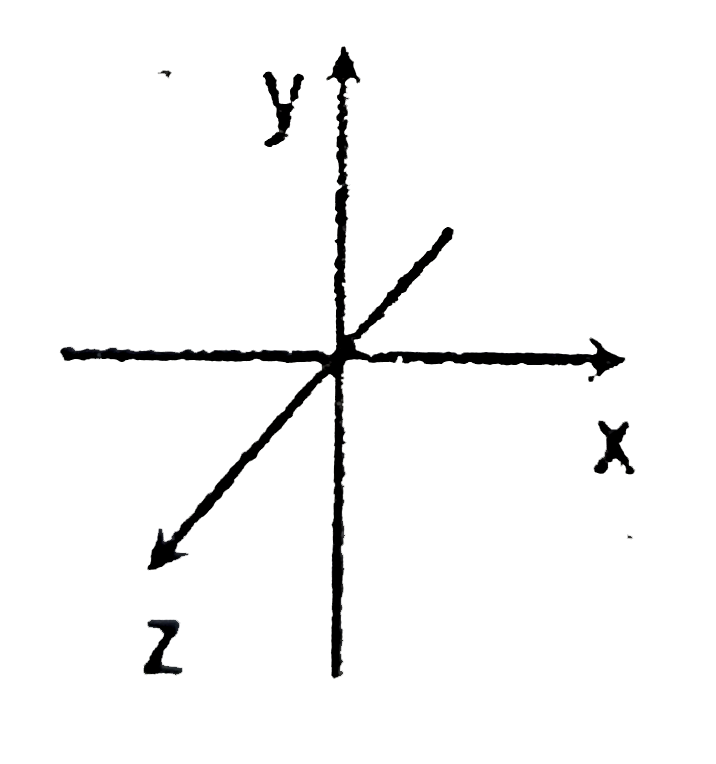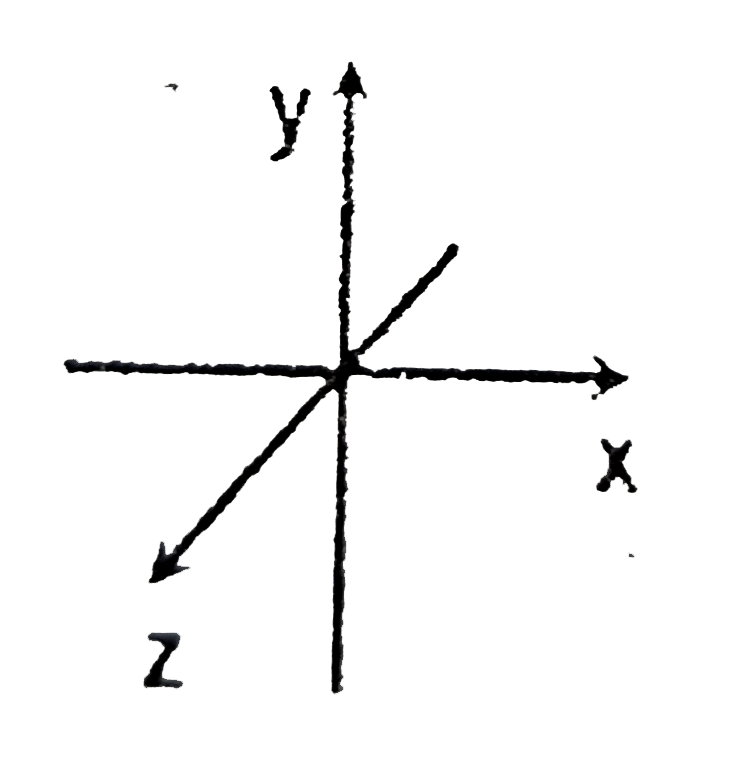A charge particle is moving along positive y-axis in uniform electric and magnetic fields
E=E0ˆk
and B=B0ˆi
Here E0 and B0 are positive constants.choose the correct options.
particle may be deflected towards positive x-axis
particle may be deflected towards negative z-axis
particle may pass undeflected
kinetic energy of particle may remain constant
The correct Answer is:A, B, C, D
To analyze the motion of a charged particle moving in uniform electric and magnetic fields, we will follow these steps:
Step 1: Identify the Given Information
The electric field E is given as E=E0^k (along the positive z-axis), and the magnetic field B is given as B=B0^i (along the positive x-axis). The charged particle is moving along the positive y-axis.
Step 2: Determine the Forces Acting on the Charged Particle
1. Electric Force: The electric force FE acting on the particle with charge q in the electric field is given by:
FE=qE=qE0^k
This force acts in the positive z-direction.
2. Magnetic Force: The magnetic force FB acting on the particle moving with velocity v in the magnetic field is given by:
FB=q(v×B)
Here, the velocity v is along the positive y-axis, v=v^j, and the magnetic field is along the positive x-axis. Therefore, we calculate the cross product:
FB=q(v^j×B0^i)=qvB0(^j×^i)=−qvB0^k
The magnetic force acts in the negative z-direction.
Step 3: Analyze the Conditions for Deflection
1. If the electric force and magnetic force are equal:
- For the particle to pass undeflected, the net force must be zero:
FE+FB=0⟹qE0^k−qvB0^k=0
This implies:
E0=vB0
In this case, the particle will not be deflected.
2. If E0>vB0:
- The electric force will dominate, and the particle will be deflected toward the positive z-axis.
3. If E0<vB0:
- The magnetic force will dominate, and the particle will be deflected toward the negative z-axis.
Step 4: Kinetic Energy Consideration
- The kinetic energy of the particle is given by:
KE=12mv2
If the particle is undeflected, its speed remains constant, and thus its kinetic energy remains constant.
Conclusion
Based on the analysis:
- The particle may be deflected toward the positive z-axis if the electric force is greater.
- The particle may be deflected toward the negative z-axis if the magnetic force is greater.
- The particle may pass undeflected if the forces are equal.
- The kinetic energy of the particle may remain constant if it passes undeflected.
Correct Options
- The particle may be deflected toward the positive z-axis.
- The particle may be deflected toward the negative z-axis.
- The particle may pass undeflected.
- The kinetic energy of the particle may remain constant.
The electric field E is given as E=E0^k (along the positive z-axis), and the magnetic field B is given as B=B0^i (along the positive x-axis). The charged particle is moving along the positive y-axis.
1. Electric Force: The electric force FE acting on the particle with charge q in the electric field is given by:
FE=qE=qE0^k
This force acts in the positive z-direction.
FB=q(v×B)
Here, the velocity v is along the positive y-axis, v=v^j, and the magnetic field is along the positive x-axis. Therefore, we calculate the cross product:
FB=q(v^j×B0^i)=qvB0(^j×^i)=−qvB0^k
The magnetic force acts in the negative z-direction.
1. If the electric force and magnetic force are equal:
- For the particle to pass undeflected, the net force must be zero:
FE+FB=0⟹qE0^k−qvB0^k=0
This implies:
E0=vB0
In this case, the particle will not be deflected.
- The electric force will dominate, and the particle will be deflected toward the positive z-axis.
- The magnetic force will dominate, and the particle will be deflected toward the negative z-axis.
- The kinetic energy of the particle is given by:
KE=12mv2
If the particle is undeflected, its speed remains constant, and thus its kinetic energy remains constant.
Based on the analysis:
- The particle may be deflected toward the positive z-axis if the electric force is greater.
- The particle may be deflected toward the negative z-axis if the magnetic force is greater.
- The particle may pass undeflected if the forces are equal.
- The kinetic energy of the particle may remain constant if it passes undeflected.
- The particle may be deflected toward the positive z-axis.
- The particle may be deflected toward the negative z-axis.
- The particle may pass undeflected.
- The kinetic energy of the particle may remain constant.
Topper's Solved these Questions
- MAGNETICSBOOK - DC PANDEY ENGLISHCHAPTER - MAGNETICSEXERCISE - SCQ_TYPE
5 Videos
- MAGNETICSBOOK - DC PANDEY ENGLISHCHAPTER - MAGNETICSEXERCISE - MCQ_TYPE
1 Videos
- MAGNETICSBOOK - DC PANDEY ENGLISHCHAPTER - MAGNETICSEXERCISE - SUBJECTIVE_TYPE
1 Videos
- MAGNETIC FIELD AND FORCESBOOK - DC PANDEY ENGLISHCHAPTER - MAGNETIC FIELD AND FORCESEXERCISE - Medical entrance s gallery
59 Videos
- MAGNETISM AND MATTERBOOK - DC PANDEY ENGLISHCHAPTER - MAGNETISM AND MATTEREXERCISE - Medical gallery
1 Videos
Similar Questions
A positively charged particle is moving along the positive x-axis in a unifom electric field→E=E0ˆj and magnetic field →B=B0ˆk (where E0 and B0 are positive constants), then
View SolutionA moving charged particle q travelling along the positive X-axis enters a uniform magnetic field B. When will the force acting on q be maximum?
View SolutionA particle of charge q and mass m is projected from the origin with velocity v=v0ˆi in a non uniformj magnetic fiedl B=−B0xˆk. Here v0 and B0 are positive constants of proper dimensions. Find the maximum positive x coordinate of the particle during its motion.
View SolutionA particle of mass m and having a positive charge q is projected from origin with speed v0 along the positive X-axis in a magnetic field B = −B0ˆK, where B0 is a positive constant. If the particle passes through (0,y,0), then y is equal to
View SolutionConsider the motion of a positive point charge in a region where there are simultaneous uniform eletric and magnetic field E=E0ˆj and B=B0ˆj. At time t=0, this charge has velocity v in the x-y-plane making an angle θ with the x-axis. Which of the following option(s) is (are) correct for time t>0?
a. If θ=00 the charge moves in a circular path in the xy-plane.
b.Ifθ=00 the charge undergoes helical motion with constant pitch along the y-axis.
c. If θ=100 the charge undergoes helicalmotion with its pitch increasing with time along the y-axis.
d. If θ=90∘ the charge undergoes linear but accelerated motion along the y-axis.
View SolutionElectric field and magnetic filed are given as E=E0sin(ωt−kx) and B=B0sin(ωt−kx) then select the correct option
View SolutionA particle of mass m and charge q is moving in a region where uniform, constant electric and mangetic fields →Eand→B are present. →Eand→B are parallel to each other. At time t=0, the velocity →v0 of the particle is perpendicular to →E (Assume that its speed is always <<c, the speed of light in vacuum). Find the velocity →v of the particle at time t. You must express your answer in terms of t,q,m, the vector →v0,→E and →B and their magnitudes →v0,→E and →B.
View SolutionA particle of mass m and charge q is moving in a region where uniform, constant electric and mangetic fields →Eand→B are present. →Eand→B are parallel to each other. At time t=0, the velocity →v0 of the particle is perpendicular to →E (Assume that its speed is always <<c, the speed of light in vacuum). Find the velocity →v of the particle at time t. You must express your answer in terms of t,q,m, the vector →v0,→E and →B and their magnitudes →v0,→E and →B.
View SolutionIn the region between the plane z=0 and z=a(a>0), the uniform electric and magnetic fields are given by →E=E0(ˆk−ˆj), →B=B0ˆi. The region defined by a≤z≤b contains only magnetic field →B=−B0ˆi. Beyond z>b no field exits. A positive point charge q is projected from the origin with velocity v0ˆk. Assuming the mass of the particle to be 23qE0av20.
The value of E0 such that the particle moves undeviated upto the plane z=a is

View SolutionIn the region between the plane z=0 and z=a(a>0), the uniform electric and magnetic fields are given by →E=E0(ˆk−ˆj), →B=B0ˆi. The region defined by a≤z≤b contains only magnetic field →B=−B0ˆi. Beyond z>b no field exits. A positive point charge q is projected from the origin with velocity v0ˆk. Assuming the mass of the particle to be 23qE0av20.
The minimum value of b such that the particle reverses its direction completely is

View Solution
